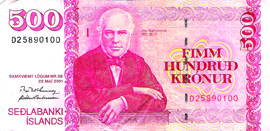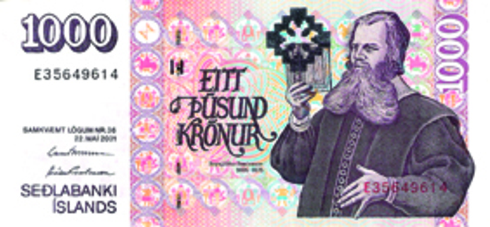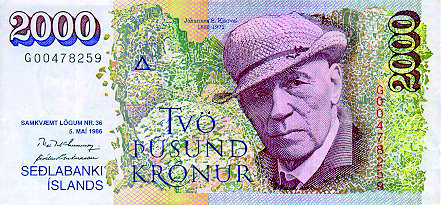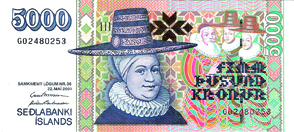Money, money, money is certainly funny, or in Iceland’s world at least. The local currency – known as the króna – has a fluctuating exchange rate that tends to differ on a weekly basis; up and down, stronger and weaker, fuller and bleaker. Mostly down, weaker and bleaker, as of late. But you get the idea.
Since the króna plummeted at an alarming rate seemingly overnight from last October, times have been good for tourists to visit, buy things, get drunk or just to gloat about their stronger currency– the British Pound, Yankee Dollar, the Euro, whatever.
Apart from the recent downfall, Iceland’s history of currency and commerce is a full and rich tale of progression and valour worthy of its own saga.
The Birth of Trade
The evolution of Icelandic currency has changed since ‘way back in the day’ when precious items such as silver, homespun cloth and even cows were the main circulation of currency between the 9th and 14th centuries. In fact cows became the most common value system for importing/exporting livestock and goods – prices were based on the cow equivalent. Like a beer would cost an udder, or something.
As times progressed so did the trading and fish over overtook those poor cows as the standard value system – manly due to the avalanche of foreign merchants stopping by at Iceland’s numerous docks in the late 14th Century. The pricing equivalence between the aforementioned methods just became ridiculous. Take a look: one cow equalled six ewes (sheep) which equalled one hundred and twenty ells of homespun, and which then equalled two hundred and forty fish. With the impending invention of shopping malls, iPods and coffee houses, a new form of currency and trade had to be established.
Welcome the Crown
The Danish Coinage Act of 1873 abolished all previous forms of currency in favour for the decimal system and the Króna was born. The first denominations of notes – issued in 1885 by Landssjóður Íslands – were of 5, 10 and 50 Krónur. 1922 saw the introduction of Iceland’s first coin, the aurar, which commenced in the values of 10 and 25 pieces. 100 aurar pieces made up to 1 króna, similar to the modern equivalent of the pence or cent. These were followed in 1925 by denominations of 1 and 2 króna pieces and in 1926 by 1, 2 and 5 aurar pieces.
Come the early 1960s, three banks were in production of printed money in paper forms, each contributing their own denomination into the cocktail of monopoly – Ríkissjóður Íslands distributing one króna notes and Landsbanki Íslands chucking in 25, 100, 500, 1000 and 5000 notes.
Like all great blockbuster movies, the sequel tends to be a lot more confusing and tedious than the first. Same for which could be said about the ‘second wave’ of Icelandic króna in 1981. A revaluation from the old 100 króna now becoming worth 1 new króna was bewildering to say the least.
Króna coins now became produced in denominations of 1, 5, 10 and a 50 piece in 1987. The 2000 denomination of Króna was also introduced, but is no longer used in main circulation – now brandished as “tourist money”, meaning that foreign exchange booths are more likely to dispense the notes than ATMs are. The introduction of the 100 Króna piece in 1995 brought the demise of aurar and eventually it became obsolete in 2003 – it was most unquestionably the end of an eyrir.
God Save The Króna
A lot has changed since the early days of commerce in Iceland. The frequent use of debit cards for purchasing quality items has cancelled out most usage for small coins, as it’s often typical to see lonely króna pieces dispersed across the streets of Laugavegur – along with the vomit from a heavy weekend. Could this be said for the UK and the States too?
Well, in the United Kingdom, for the value of a Pound you can grab yourself a few cans of non-branded baked beans and a loft of chemically altered bread. Maybe a can of strong supermarket cider and a packet of ‘beef flavour’ corn snacks or even a plastic photo frame.
For a dollar, you can only grab mainly food related items. Especially cheeseburgers from a clown fronted chain fast food eatery or various confectionaries from vending machines. Or even practical uses like to topping up a parking meter.
One hundred Króna will get you six plastic bags from your local convenient store, a tiny chocolate bar depending on where you shop or a small carton of Svali also depending where you shop. According to most folk, the best way to spend your golden crown is a small tub of flavoured skyr from Bónus.
To some, the Króna may look similar to the well-known ‘pretend money’ dealt out during a popular economical domination board game. However with up to 12 security features printed on each note, this physical form of the Króna is surely no fugazi. Have you ever wondered what the difference in the notes detail and complexity are? Let’s take a gander.

Value: 500 Krónur
Obverse Print: Jón Sigurðsson was leader of the Icelandic Independence movement in the 19th Century. He believed in freedom of the individual, the need for the country to be independent, respect for the cultural and religious traditions, especially the preservation of the Icelandic language and no doubt, keeping its own currency.
Reverse Print: Jón Sigurðsson at his writing desk, with tapestry and other belongings.
Type of Paper: Made of raw cotton.
Colour: Red.
Date Issued: 1981.
Size: 145 x 70 mm.
Watermark: Portrait of Jón Sigurðsson.
Blind Recognition Feature:One vertical line is intaglio-printed on the obverse.

Value: 1000 Krónur
Obverse Print: Lutheran Bishop Brynjólfur Sveinsson who helped to build the church Brynjólfskirkja in the village of Skálholt – and has a beard shaped like a scrotum. The written denomination is in the same typeface inscription as the baptismal font of Brynjólfskirkja.
Reverse Print: A cross-section and portrait of Brynjólfskirkja. At the side is an image of the Madonna gold ring owned by Bishop Brynjólfur Sveinsson.
Type of Paper: Made of raw cotton.
Colour: Purple.
Date Issued: 1984.
Size: 150 × 70 mm.
Watermark: Portrait of Jón Sigurðsson.
Blind Recognition: Two vertical lines are intaglio-printed on the obverse.

Value: 2000 Krónur
Obverse Print: Slap bang on the front is the mug shot of Jóhannes Sveinsson Kjarval, one of Iceland’s most famous artists. Kjarval was once criticized due to his unconventional blend of realistic landscapes and mythical subjects, but he was well respected enough in the end to be featured on the note. Even though it’s a note no one likes.
Reverse Print: Jóhannes’s painting ‘Yearning for Flight’ and his drawing ‘Woman and Flowers’.
Type of Paper: Made of raw cotton.
Colour: Yellow, Green and a bit of Red.
Date Issued: 1995.
Size: 150 × 70 mm.
Watermark: Portrait of Jón Sigurðsson.
Blind Recognition: A triangle is intaglio-printed on the obverse.

Value: 5000 Krónur
Obverse print: Illustrated is Ragnheiður Jónsdóttir. Ragnheiður was the daughter of the priest Jón Arason and wife of two consecutive Bishops – Gisli Þorláksson and Einar Þorsteinnsson (not at the same time, obviously). The lettering is copied from the Laufáskirkja alter cloth at the National Museum of Iceland.
Reverse print: The reverse depicts Ragnheiður instructing two girls in the art of embroidery.
Type of Paper: Made of raw cotton.
Colour: Blue, purple and green.
Date Issued: 1986.
Size: 155 × 70 mm.
Watermark: Portrait of Jón Sigurðsson.
Blind Recognition: Three vertical lines are intaglio-printed on the obverse.
Buy subscriptions, t-shirts and more from our shop right here!

















